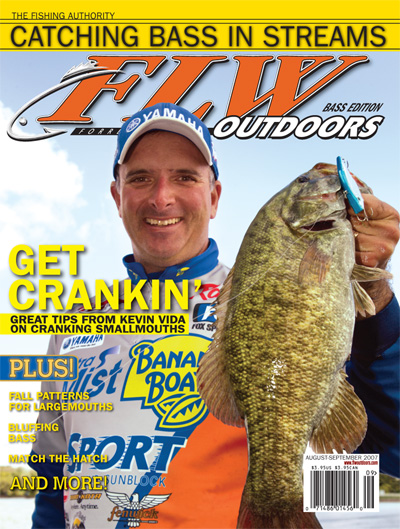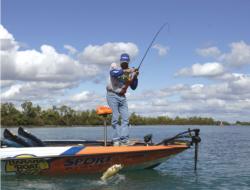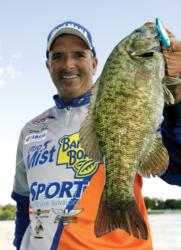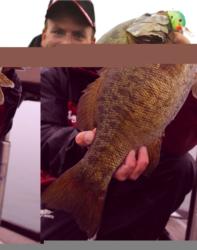Crankin’ smallmouths
Banging bottom is not just a largemouth technique anymore

Rock ‘n’ roll fans always want to “crank up” the music. NASCAR drivers are always telling their mechanics to “crank up” the power in their cars. But “cranking up” bass means something entirely different in fishing circles. There’s just something exhilarating about those days when you can do no wrong, and the bass are attacking every wobbling, rattling bait being bumped into any piece of cover around them. Bass fishermen dream of catching bass after bass on cast after cast every time they launch the boat.
But, for many bass anglers, cranking means catching largemouths with big diving plugs. Many fishermen don’t realize how potent crankbaits can be for smallmouths. Bronzebacks are a forage-driven species of fish, and when the shad start to make big migrations in early spring and early fall, bass anglers can take advantage of their ferocity and actually predict where they will be year after year.
Long-time Detroit River expert and Banana Boat pro Kevin Vida of Clare, Mich., knows a thing or two about probing the flats for smallmouths with crankbaits. He’s won two Stren Series events and three Wal-Mart Bass Fishing League events in the Detroit River area of Michigan. So when Vida speaks of cranking for smallies, people listen.
Another Lake Erie and Detroit River legend is Joe Balog of Harrison Township, Mich. Balog won a major tournament on Erie last year and has had two wins and 22 top-10s in FLW Outdoors events on Lake Erie and the Detroit River. Like Vida, Balog has spent a great deal of time experimenting and figuring out ways to catch more smallmouths in the spring and fall. In fact, his heaviest limit while fishing on Lake Erie came a couple years ago. The five smallmouths weighed 27 pounds, collectively, and all were caught on a crankbait.
When to look for crankbait-ripe bass
 “It’s really an early spring and early fall thing for me,” Vida said. “Shad migrate in big schools into the rivers from Lake Erie and Lake St. Clair. The baitfish move in large schools through the flats along the river. They will tuck into any holes and openings in the grass to get out of the current as they migrate.”
“It’s really an early spring and early fall thing for me,” Vida said. “Shad migrate in big schools into the rivers from Lake Erie and Lake St. Clair. The baitfish move in large schools through the flats along the river. They will tuck into any holes and openings in the grass to get out of the current as they migrate.”
Balog also likes the early fall season when big migrations of shad are coming out of Erie and St. Clair and back into the river. “I’ve also had some phenomenal crankbait days in May and June on the river, as well as on Lake St. Clair,” Balog said.
Choose your weapon carefully
 Vida’s bait of choice is a 1/2-ounce Berkley Frenzy Rattl’r in chrome blue. He gears up with a 7-foot medium-heavy-action Fenwick Techna AV rod and either 14-pound Berkley Vanish or Trilene fluorocarbon.
Vida’s bait of choice is a 1/2-ounce Berkley Frenzy Rattl’r in chrome blue. He gears up with a 7-foot medium-heavy-action Fenwick Techna AV rod and either 14-pound Berkley Vanish or Trilene fluorocarbon.
“Some people like limber rods and light line for cranking,” Vida said, “but I want to be able to drive the hook on the hookset, and you have to have some backbone to get a hook in these fish. Now, if I have a problem with bass just nipping at the baits or striking and not getting hooked up, I might go to a glass rod for a little more forgiveness.” The lighter-action glass rods give those shy biters a little extra time to load up on the hook before yanking it away on the hookset.
Balog is in the same camp as Vida on heavy tackle. He goes a bit heavier, though, with a 7-foot heavy-action Daiwa Cielo graphite rod, but uses lighter line, opting instead for 12-pound Berkley Vanish.
“A big smallmouth will crash into a crankbait, unlike a largemouth that will usually just inhale the bait haphazardly,” Balog said. “I can fight them aggressively. They come up and jump, and I continue to reel through their jumps. I replace all my crankbait hooks with Gamakatsu hooks. It’s just like the other power techniques. I hook them fast and fight them fast.”
Both anglers like high-speed reels for more power. Vida opts for the Revo STX, and Balog opts for a high-speed Daiwa TD Zillion. Balog also cautioned about fatigue. “Reels with bigger handles will help with fatigue and grip after throwing heavy baits all day,” Balog said. “I like to put ReelGrip handle grips  on my reel handles to add some mass and traction to the handle.”
on my reel handles to add some mass and traction to the handle.”
Balog prefers diving crankbaits for smallmouth fishing. He keys on tight-wobbling lures most of the time. “A smallmouth prefers a tight wiggle about 90 percent of the time, and the other 10 percent, they like a wide-wobbling bait,” Balog said. “That is also when they like spinnerbaits, jerkbaits and the rest of the tackle box, though.”
Balog’s baits of choice are a Rapala DT10, a Rapala DT16, a Norman Lures DD22 and Poe’s cedar crankbaits. He primarily sticks to chartreuse-sided baits and dull, shad-colored baits. He doesn’t want his shad baits to be too flashy. Depending on water clarity, he’ll usually throw either a chartreuse crankbait with a blue back or a white crankbait with a purple back.
Triggering the fish
As for retrieves, Vida varies his retrieve depending on the mood of the fish. He’ll crank his lipless bait along at a medium to medium-fast speed, and when the bait buries a little grass, he rips it out. It’s similar to the techniques used on grassy lakes in Texas and Florida for catching largemouths on a lipless crankbait.
His other retrieve is more of a stop-and-go, where he just pumps the bait along with his rod. He sweeps the bait up, raising his rod tip to the 10 or 11 o’clock position, then he reels his slack as he lowers his tip to prepare another sweep. That sweeping action is deadly when the bait drops into a  hole in the grass, and many smallmouths hit the bait out of sheer reaction to the sudden change in speed and direction.
hole in the grass, and many smallmouths hit the bait out of sheer reaction to the sudden change in speed and direction.
Balog likes to stick to a medium-fast retrieve. “You want the bait to be hitting bottom some of the time, but it’s not always necessary when smallmouths relate to current,” he said.
Where to find fish
Vida’s system revolves around grass, and Balog’s system revolves around rock. Occasionally, the two systems intersect. Vida looks for areas where migrating shad will first be looking to rest out of the current, namely the flats in the mouths of the rivers. As the shad migrate into the river from the lake, they will pile up in the holes and openings in the grass. Sometimes the holes are the size of a basketball, and sometimes they are larger than your boat.
“I do a lot of scouting with my eyes,” Vida said. “I start in an area and just get on the trolling motor and cover water, casting to good-looking spots on the flat.”
 It’s not until he starts to catch bass that Vida employs his GPS to perfectly triangulate each pocket that’s holding fish. But he cautions anglers on the effects of current and wind. “Rivers like the Detroit River flow one way, but the wind can wreak havoc on the natural current and reposition the fish,” Vida said. “The river has several channels on it, and wind can back the current up and force it to flow down another channel much stronger. When this happens, the fish will pull out of the holes and scatter. So you have to keep looking for the right current conditions to consistently find the fish.”
It’s not until he starts to catch bass that Vida employs his GPS to perfectly triangulate each pocket that’s holding fish. But he cautions anglers on the effects of current and wind. “Rivers like the Detroit River flow one way, but the wind can wreak havoc on the natural current and reposition the fish,” Vida said. “The river has several channels on it, and wind can back the current up and force it to flow down another channel much stronger. When this happens, the fish will pull out of the holes and scatter. So you have to keep looking for the right current conditions to consistently find the fish.”
Balog agreed current is the key, but differed on the areas he targets. “If you compare crankbait fishing here to anywhere else in the country, bass always bite crankbaits best when there is some current being generated,” Balog said.
Breaklines hold the best smallmouths for Balog. Instead of looking for weeds that break the current, Balog looks for rocks or boulders in water that drops from 6, 8 or 10 feet to 10, 12 or 14 feet deep. “The fish won’t be tight to those drops, either,” Balog said. “You might catch a few right up there where it breaks off, but the better fish usually congregate in the eddy that is generated by the rock on the break itself. If the water is flowing over the rocks and then it suddenly drops off, there is a little eddy that comes off that break. If you have a boulder or a rock pile there, the eddy is going to be larger.”
Some eddies extend 10 feet out from the drop, and sometimes targeting fish in those eddies can be difficult. “You have to visualize what’s under there and study how the current is moving through the  area,” Balog said. “Then you have to position yourself so you can throw at a 45-degree angle to the current and the boulder or break. If you come straight across it or down the side of it, you’ll miss that eddy, but if you work at it from an angle, you can bring your bait through the sweet spot each time.
area,” Balog said. “Then you have to position yourself so you can throw at a 45-degree angle to the current and the boulder or break. If you come straight across it or down the side of it, you’ll miss that eddy, but if you work at it from an angle, you can bring your bait through the sweet spot each time.
“You can make 10 casts to an area that is only 20 feet by 20 feet, and one cast will be the cast where you hit it at just the right angle and catch a smallmouth. Then you can make 10 more casts at that exact same angle and catch bass every time.
“It takes tremendous concentration to do this because you’re constantly looking at your GPS, casting, and when you find the right angle, you have to duplicate it,” Balog said. “The problem enters when you take your foot off the trolling motor to fight the fish, and you drift away. You have to visualize your cast and triangulate with something on the bank in the direction you’re casting and in another direction to the side. Then, when you get back to your GPS point, you can line up again on the right angle.”

The fish are very in tune to how baitfish move in the current. “The way I got good at this was going to the river every day when the fishing was good in the fall and throwing nothing but crankbaits,” Balog said. “If you commit yourself to any technique like that, whether it be flipping, cranking or skipping docks, that’s when you really get good at something.”
The other thing both anglers have found is that the fish will come back to the same areas and spots year after year. “You basically check all the spots you know and try to find a few more similar spots close by each year,” Balog said. “They might come back one year and then not use that rock pile for three years, but I still check it every year.”
Balog’s GPS tricks
Balog relies heavily on his GPS units to stay on top of his spots while fighting the current. “It’s hard to build up confidence at first, because you’re constantly fighting the current, and you think you are moving faster than you really are, so you lose your bearings,” he said. “That’s why you rely on your  GPS. You keep moving and cast shallow, and then cast deep; then change your angle and do it again. As you catch fish, you start to waypoint spots and grid the structure on your GPS to find that right angle and sweet spot.”
GPS. You keep moving and cast shallow, and then cast deep; then change your angle and do it again. As you catch fish, you start to waypoint spots and grid the structure on your GPS to find that right angle and sweet spot.”
The true big-fish spots that hold really big smallmouths are not going to produce 50 or 60 bass. You’ll catch just a few fish, but it’s critical to make the right cast. “It’s crucial to have a GPS on your front unit,” Balog said. “You need to see the rock pile on your graph, but you also need to see the GPS point to get lined up each time. Anglers assume they are hitting the spot each time, but maybe they didn’t realize they let off the trolling motor three times. Now they’ve slid back 60 yards and aren’t on the spot anymore.
“One little trick I do is after I hook a fish is hit the cursor key on my GPS left or right one time. I don’t kick over a buoy because that will blow off the spot and slip in the current. Now you have an arrow on your track line that freezes where you were when that fish hit. As you drift back fighting and releasing that fish, you can motor right back up to where you froze the screen and get back on your track again to catch another one.”